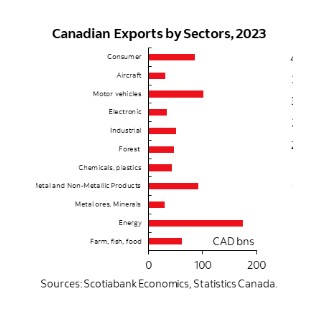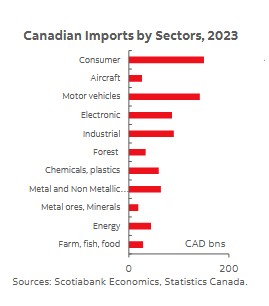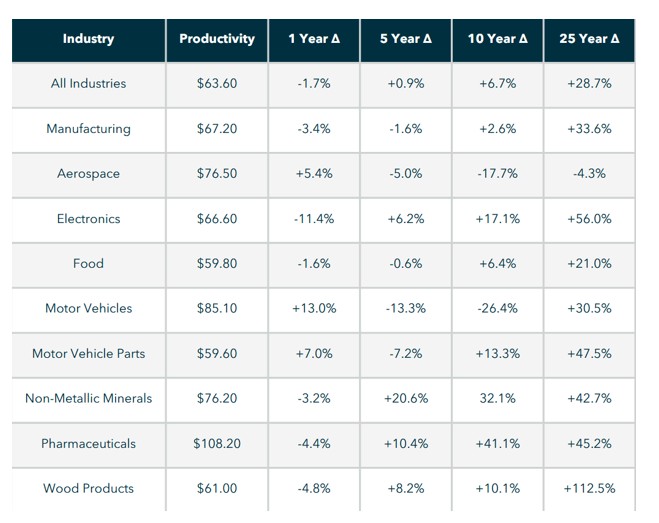05, June 2025
Should we manufacture more in Canada?
On of the (many) stated aims of the US tariffs in to create more manufacturing jobs in the US. What about manufacturing in Canada? Should we try to increase manufacturing too?
Trends
In both Canada and the US manufacturing has steadily declined as a percentage of GDP and employment over the last fifty years. This has been the same in all OECD countries. In the 1950’s and 60’s manufacturing represented more than a quarter of the economy in both countries, but by 2024 it had declined to 10-11% of GDP in both countries. Manufacturing employment has also declined, from almost 2 million in Canada in 2001 (15% of the industrial workforce) to 1.6 million in 2024 (8.6% ), according to Statistics Canada. The main reason for this is the faster growth of the service sector.
The definition
The definition of manufacturing isn’t completely straightforward. Technically manufacturing is in NAICS (North American Industrial Classification System) codes 31-33. According to ISED: This sector comprises establishments primarily engaged in the physical or chemical transformation of materials or substances into new products. These products may be finished, in the sense that they are ready to be used or consumed, or semi-finished, in the sense of becoming a raw material for an establishment to use in further manufacturing.
Examples of manufacturing are food manufacturing, the chemical industry, oil refineries, furniture manufacturing, transportation equipment, and machinery manufacturing. The oil sands, that have a lot in common with oil refineries, are not classified as manufacturing but as NAICS code 211, oil and gas extraction.
Are manufacturing jobs better?
There is a long running debate among politicians about whether manufacturing jobs are “better” than services jobs. A brief summary from the Economist provides a good answer to this question “The nostalgia of politicians is misplaced.”
According to Statistics Canada the average hourly wage in manufacturing jobs in 2024 in Canada was $34.32. The average hourly wage in the services sector was $34.74, so not much difference. However, there is a wide range of wages in the service sector, from a high of $47.50 in professional, scientific and technical services, to a low of $20.58 in accommodation and food services
Research and Development.
The manufacturing sector spends a quarter of Canada’s business R&D. However Canadian owned firms spend more than foreign owned firms on R&D as a percent of revenue (1.8% vs. 1.1%). This is in marked contrast to the service sector where foreign owned firms spend more than twice as much as Canadian owned firms (5.7% vs 2.4%), according to Statistics Canada.
Exports.
According to a report from ScotiaEconomics, total Canadian exports in 2023 were $965 billion. Of these, 20% ($197 billion) were services, and 80% ($768 billion) were goods.
Of the goods exports, $467 billion was manufacturing, according to ISED. So manufacturing represents 48% of Canada’s total exports. For comparison energy exports were $174 billion, 18% of total exports.
So, manufacturing exports are a very significant part of Canadian exports.
Imports
In 2023 Canada’s total imports were $978 billion, of which 79% were goods and 21% services. The main imports are shown below. Most of these are manufactured goods.

Where is manufacturing in Canada?
There were 93,870 manufacturing establishments in Canada in 2023, of which 93% were small businesses, having fewer than 100 employees. The distribution of manufacturing jobs among provinces is shown below. The largest amount of manufacturing is in Ontario, but the highest share of the economy is in Quebec. But manufacturing represents at least 5% of the economy in nine provinces.
| Province | Manufacturing GDP 2022, $ billions | Provincial GDP
2022 $ billions |
Manufacturing as % GDP |
| Ontario | $84.8 | $850.5 | 10 |
| Quebec | $49.2 | $434.5 | 11.3 |
| Alberta | $24.1 | $336.3 | 7.2 |
| BC | $16.8 | $302.1 | 5.6 |
| Manitoba | $6.3 | $69.2 | 9.1 |
| Saskatchewan | $5.1 | $76.1 | 6.7 |
| New Brunswick | $3.1 | $34.6 | 9.0 |
| Nova Scotia | $2.8 | $43.6 | 6.4 |
| Newfoundland | $0.8 | $29.6 | 2.7 |
| PEI | $0.7 | $7.1 | 9.9 |
Source: Statistics Canada
Productivity.
According to the NGen Productivity Report manufacturing has increased its labor productivity by 33.6% over the last 25 years, about 17% more than all industries. But several manufacturing sectors – wood products, electronics and motor vehicle parts – have increased their productivity by much more, see the table below.
According to ISED, manufacturing labour productivity from 2018 to 2022 actually decreased , compared to a very small increase for the economy as a whole.

However, productivity can increase and decrease, for many reasons. For example, the move from large breweries to craft breweries decreased productivity in that sector as smaller plants are less productive than large plants. The aerospace industry is less productive now than it was 25 years ago. In food manufacturing–the largest manufacturing industry in Canada in terms of employment– productivity growth has not kept pace with the overall manufacturing sector.
International comparisons.
The table below shows the share of manufacturing in GDP for the G7 countries.
| Country | Manufacturing share of GDP 2022 |
| Germany | 19 |
| Japan | 10 |
| Italy | 15 |
| US | 11 |
| France | 10 |
| Canada | 9 |
| UK | 8 |
Source: World Bank
For comparison, China’s current share is 26% (similar to Canada’s share in the 1960’s), the OECD average is 13%, and Australia is 5%.
Foreign ownership.
According to Statistics Canada, 44% of the manufacturing sector in Canada is foreign owned, the second highest sector behind wholesale trade at 48%. This is far above the national average, where about 15% of assets are foreign owned.
Conclusion.
The manufacturing sector in Canada contributes 10% of GDP and about 1.6 million direct jobs. It contributes 48% of Canadian exports. Despite political rhetoric to the contrary manufacturing jobs are no “better” than services jobs. The productivity performance of the sector is higher than the average of Canadian industry but recognizing that Canadas productivity performance as a whole has been very poor.
In terms of future actions, rather than trying to bring to Canada activities that are done more efficiently elsewhere, it would seem to make more sense to focus on increasing the productivity of the current manufacturing sector. One area that is poised for significant growth is the defense sector, where 585 firms generate $14 billion revenue.
One possible impediment to improving manufacturing in Canada is the large amount of foreign ownership, where US owners may be tempted to move operations to the US.

Leave A Comment
You must be logged in to post a comment.